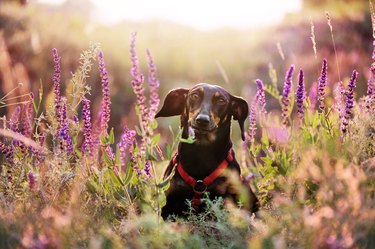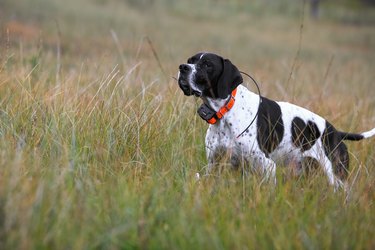
Benadryl is a common over-the-counter antihistamine that has been around since 1946. You may have taken it for a bug bite or to help alleviate seasonal allergies and wondered if your dog can take it too when they experience the same thing. Many dogs can take Benadryl, also known as diphenhydramine, but dogs with certain health conditions should avoid it.
Benadryl for allergies in dogs
Video of the Day
Benadryl is an antihistamine, which means it blocks histamine receptors. Histamine is a chemical that has many functions, one of which is to serve as a mediator for itching during an immune response to things like allergens.
Video of the Day
Common symptoms of dog allergies are watery eyes, runny nose, itching or sneezing. If your dog experiences any of these due to seasonal or year-round allergies, they may get relief from taking Benadryl.
Some dogs with itchy skin or itchy ears due to food allergies may also benefit from taking this antihistamine. But like many medications, some dogs may not respond to it. If your dog's allergy symptoms aren't improving after being on Benadryl for two weeks, talk to your veterinarian about another alternative.

Benadryl for insect bites and stings in dogs
The inflammation caused by bug bites or insect stings can be alleviated with Benadryl. However, if your dog gets stung by a bee and experiences facial swelling or hives, take them to your veterinarian right away. They may need to get the injectable form of diphenhydramine along with a corticosteroid injection to help reduce symptoms and calm the immune system faster than taking medication by mouth.
Using Benadryl for anxiety in dogs
Though Benadryl isn't an anxiety medication, it is often used for its mild sedative effect to help dogs who have anxiety related to thunderstorms or fireworks. The medication acts on your dog's nervous system to cause sedation, so sudden noises like thunder won't be as startling.
If your dog gets anxious on car rides or plane trips, Benadryl might cause enough sedation that your dog can sleep through part of the trip. Sometimes, travel anxiety can be from your dog associating car trips with nausea. Though Benadryl isn't specifically labeled as an anti-vomiting medication, it can lessen nausea because it is related to the active ingredient in the motion sickness preventative, Dramamine.

Benadryl for mast cell tumors in dogs
Mast cell tumors are the most common type of skin cancer in dogs, accounting for 14 - 21 % of canine skin tumors. According to Merck Veterinary Manual (a common reference for DVMs,) this cancer is also the most common malignant tumor in dogs in general.
If your dog has been diagnosed with a mast cell tumor, your veterinarian will advise you on further testing to look for signs of spread as well as treatment options depending on what grade of tumor your dog has. They will also likely have you give your dog diphenhydramine to combat the histamine that mast cells release.
Benadryl dosage for dogs
In the United States, this antihistamine comes in liquid as Children's Benadryl Allergy as well as tablets for children and adults. Liquid Benadryl has 12.5 mg per 5 ml of the active ingredient, diphenhydramine. The children's tablets contain 12.5 mg and the adult Benadryl Allergy tablets come in 25 mg and 50 mg.
Don't get combination Benadryl products that are for allergies and congestion because these contain an additional active ingredient. Though diphenhydramine does not come in a time-release formula like some antihistamines, it's good to note that dogs should avoid time-release products in general due to differences in how dogs absorb them.
The correct dog dose for Benadryl is 1 mg per pound of body weight every 8 to 12 hours. So a 25-pound dog would take one 25 mg tablet. Depending on their weight, small dogs might need to take part of a 25 mg tablet or all or part of a 12.5 mg tablet. Another alternative is the liquid Benadryl. For proper dosing, ask your veterinarian for a syringe.
Depending on your dog's situation and condition, your veterinarian will advise you if your pet should take a higher or lower dose. For travel, you'll want to administer this medication at least 30 minutes before your trip.
Common side effects of Benadryl for dogs
Common side effects of diphenhydramine include:
- Drowsiness
- Increased heart rate
- Increased respiratory rate or difficulty breathing
- Urinary retention
- Dry mouth or dry throat
Benadryl precautions for dogs with certain conditions
If your dog has any of the following medical conditions, they should not take Benadryl without first talking with your veterinarian:
- Heart conditions
- High blood pressure
- Low blood pressure
- Glaucoma
- Prostate disease
- Hyperthyroidism
- Lung disease
- Pregnancy
If your dog takes the antihistamine cetirizine (also known as Zyrtec,) they shouldn't take Benadryl because the side effects can be compounded. In some countries like the United Kingdom, Benadryl Allergy is not diphenhydramine but cetirizine, so be sure to read the active ingredient on the back of the box if you travel with your dog to other countries.
It's not unusual for dogs to be on human medications, so if you want to try Benadryl, ask your veterinarian about potential side effects and drug interactions.

The bottom line
Benadryl can be helpful if your dog has environmental or food allergies. It can also help reduce itching and inflammation should your dog get stung or bit by an insect. Benadryl is generally considered safe to use in dogs though pets with certain health conditions should avoid this medication. Talk to your veterinarian before starting your dog on Benadryl.